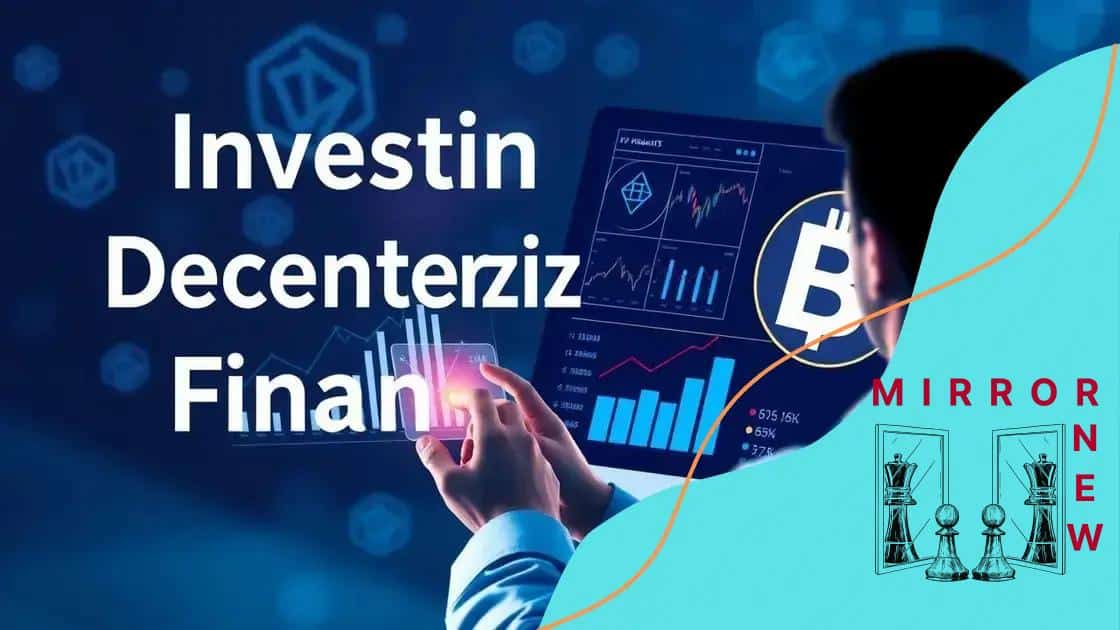Decentralized finance (DeFi) opportunities in 2025

Decentralized finance (DeFi) offers innovative financial services without intermediaries, allowing users to lend, borrow, and trade assets, while also presenting risks like volatility and smart contract vulnerabilities.
Decentralized finance (DeFi) opportunities in 2025 are set to disrupt traditional financial systems. Have you ever wondered how these innovations could impact your financial future? Let’s dive into the exciting possibilities ahead.
Understanding decentralized finance today
Understanding decentralized finance today is crucial as it offers new possibilities for everyone involved in finance. Whether you’re an investor or just curious about finance, there are opportunities to explore.
What is decentralized finance?
Decentralized finance, or DeFi, refers to financial services that operate without traditional intermediaries like banks. Instead, they use smart contracts on blockchains. This technology allows users to lend, borrow, and trade directly with each other.
Benefits of decentralized finance
- Accessibility: DeFi platforms are open to anyone with an internet connection.
- Transparency: Transactions on the blockchain can be viewed by anyone, enhancing trust.
- Lower fees: Without intermediaries, users can save on transaction costs.
- Innovative products: DeFi introduces products like yield farming and liquidity pools, which are not available in traditional finance.
As we explore this new landscape, it’s essential to recognize that while decentralized finance offers many advantages, there are also risks involved.
Smart contracts can have vulnerabilities, and users need to be cautious. Additionally, the regulatory environment is still evolving, which can impact the use and safety of these platforms. Staying informed about both the opportunities and risks is vital for making sound decisions.
Overall, understanding decentralized finance today prepares you for the future of finance as it continues to grow and change. People are finding exciting ways to engage with their finances through this technology. Will you be one of them?
Key trends in DeFi for 2025
Key trends in DeFi for 2025 are shaping the future of finance. As technology evolves, several patterns are emerging that will redefine how we interact with money.
Increased Adoption of Layer 2 Solutions
Layer 2 solutions enhance the scalability of blockchains. They are crucial for making decentralized finance more accessible. By improving transaction speeds and lowering fees, these solutions attract more users to DeFi platforms.
Growth of Decentralized Autonomous Organizations (DAOs)
DAOs will play a significant role in shaping governance models in DeFi. These organizations allow users to participate in decision-making processes through voting mechanisms. As more people engage with DAOs, they will be able to influence the future direction of project development and funding.
- Community-driven: DAOs promote community involvement.
- Transparent governance: All decisions are public and traceable.
- Automated systems: Reduced need for centralized authority can increase efficiency.
Additionally, projects that integrate social tokens will emerge. These tokens represent ownership and value within a community. Creators and fans can utilize these tokens for various benefits, like exclusive access to content or events.
As we look ahead, the integration of artificial intelligence in DeFi applications will also transform how we analyze data and make financial decisions. AI-driven analytics can provide users with better insights and guide investment strategies.
Security will remain a major concern in decentralized finance as well. Projects will need to focus on improving security measures to protect users’ funds and data from malicious attacks. The evolution of insurance products for DeFi will also become a priority to ensure safer transactions.
How to invest in DeFi projects

How to invest in DeFi projects is an essential question for anyone looking to enter this exciting financial space. With many opportunities available, knowing where to start can make a significant difference.
Researching DeFi Projects
Before investing, it’s crucial to do thorough research. Understanding each project’s purpose and technology can help you make informed decisions. Focus on key aspects such as the team behind the project, the use case of the token, and its roadmap.
Evaluating the Risks
Investing in decentralized finance comes with risks. Prices can be extremely volatile, and projects may fail. Identifying potential red flags, like lack of transparency or an unverified team, is vital for protecting your investment.
- Read Whitepapers: These documents provide detailed insights into the project.
- Check Community Activity: Active and engaged communities often indicate a strong project.
- Analyze Market Trends: Understanding market conditions can help you time your investments better.
Once you’ve done your research, consider how you want to invest. You can buy tokens on various exchanges or provide liquidity through decentralized exchanges (DEXs). Both methods come with their own benefits and challenges.
When investing through DEXs, you can participate in liquidity pools. This method lets you earn rewards while providing assets for trading. However, remember to assess impermanent loss and fees associated with these transactions.
Additionally, diversifying your investments across multiple DeFi projects can help mitigate risk. By spreading your investments, you can lower the impact of any single project underperforming.
Risks associated with DeFi investments
Risks associated with DeFi investments are an important consideration for anyone exploring this financial landscape. While there are exciting opportunities, being aware of potential issues can help protect your assets.
Smart Contract Vulnerabilities
One major risk in decentralized finance comes from smart contracts. These self-executing agreements can have bugs or vulnerabilities. If there is a flaw in the code, attackers may exploit it, leading to significant losses.
Market Volatility
The crypto market is known for its volatility. Prices can rise and fall rapidly, which can be stressful for investors. It’s crucial to manage your expectations and understand that DeFi assets may not always behave as traditional investments.
- Liquidity Risk: Some DeFi projects may lack sufficient liquidity, making it hard to buy or sell assets when needed.
- Regulatory Risks: As governments worldwide look at DeFi, changes in regulations can impact operations and access.
- Impermanent Loss: When providing liquidity to pools, fluctuations in asset prices can lead to losses compared to holding the assets outright.
Another concern is the risk of fraud and scams. As decentralized finance continues to grow, so does the potential for bad actors. Always verify a project’s legitimacy before investing.
Moreover, relying on centralized exchanges for transactions can expose you to additional risks. If the exchange is compromised or goes offline, accessing your funds can become difficult. As a safety measure, consider keeping your assets in a secure wallet.
Overall, being well-informed about these risks is essential when investing in DeFi. Doing your homework can help you navigate this innovative but tricky territory more safely.
Future of DeFi and traditional finance
The future of DeFi and traditional finance is an exciting area to explore. As decentralized finance continues to grow, it challenges the norms of conventional banking.
Integration of DeFi with Banking Services
Many traditional financial institutions are beginning to embrace DeFi. This integration can offer customers a blend of both worlds, providing high returns from decentralized platforms alongside the security and trust of well-established banks.
Impact on Financial Inclusion
Decentralized finance has the potential to increase financial inclusion. With blockchain technology, individuals who have been underserved by traditional banks can access financial services. This means more people can save, invest, and borrow money.
- Access to Global Markets: Anyone with internet access can join the DeFi space.
- Lower Costs: Traditional barriers are removed, reducing fees associated with transactions.
- New Opportunities: Individuals can invest in various assets without needing a bank account.
Moreover, as DeFi matures, it may lead to the development of new financial products. These could include innovative lending solutions, insurance products, and more. This evolution could change how consumers interact with their finances on a global scale.
Despite the challenges that DeFi faced, it also opens the door for stricter regulations. As more traditional institutions participate, the regulatory landscape will likely evolve. This balance between innovation and regulation is crucial for the future.
Overall, the intersection of DeFi and traditional finance holds great promise. As both sectors learn from each other, we can expect a more efficient and inclusive financial system to emerge in the coming years.
FAQ – Frequently Asked Questions about DeFi Investments
What is decentralized finance (DeFi)?
Decentralized finance (DeFi) refers to financial services that operate on a blockchain, allowing users to lend, borrow, and trade without traditional intermediaries.
What are the main risks of investing in DeFi?
Major risks include smart contract vulnerabilities, market volatility, and potential for fraud and scams.
How can I invest in DeFi projects?
You can invest in DeFi projects by buying tokens on decentralized exchanges or providing liquidity in liquidity pools.
What is the future of DeFi and traditional finance?
The future will likely see more integration between DeFi and traditional finance, enhancing accessibility, efficiency, and financial inclusion.





